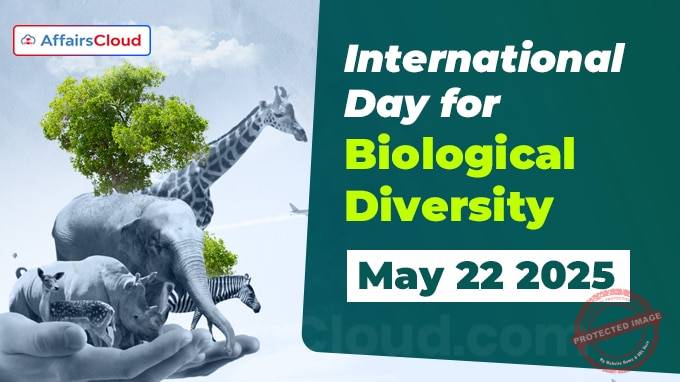 The United Nations (UN’s) International Day for Biological Diversity (IDB) is observed globally on May 22 every year to raise awareness about biodiversity conservation and its critical role in sustaining life on Earth.
The United Nations (UN’s) International Day for Biological Diversity (IDB) is observed globally on May 22 every year to raise awareness about biodiversity conservation and its critical role in sustaining life on Earth.
- The Convention on Biological Diversity (CBD) oversees the observance of the IDB and acts as the UN’s key framework for safeguarding global biodiversity.
2025 Theme:
The theme for IDB 2025 is “Harmony with Nature and Sustainable Development.”
- It emphasizes aligning global efforts to achieve the 2030 Agenda for Sustainable Development (SDGs) and the Kunming-Montreal Global Biodiversity Framework (KMGBF).
Background:
i.The United Nations General Assembly (UNGA) first designated 29 December as IDB in 1995 through resolution A/RES/49/119.
ii.However, in 2001, the UNGA, through resolution A/RES/55/201, shifted the date of IDB to May 22.
iii.The inaugural IDB was observed on May 22, 2002.
Why 22 May?
i.This date commemorates the adoption of the text of the Convention on Biological Diversity (CBD) at the Nairobi Conference in 1992.
ii.The CBD was later opened for signing at the United Nations Conference on Environment and Development (UNCED), also known as the Rio Earth Summit, on 5 June 1992 in Rio de Janeiro, Brazil.
What is Biodiversity?
Biodiversity encompasses the variety of all life forms on Earth, including different plants, animals, microorganisms, the genetic information they contain, and the ecosystems they form.
i.Biodiversity provides essential services:
- Food Security: Over 80% of the human diet is plant-based, and fish provide 20% of animal protein to about 3 billion people.
- Health: Approximately 80% of people in rural areas of developing countries rely on traditional plant-based medicines.
- Ecosystem Services: Biodiversity supports vital ecosystem functions like pollination, water purification, and climate regulation.
ii.Threats:
- Habitat Destruction: Deforestation, urbanization, and agricultural expansion.
- Pollution: Contamination of air, water, and soil.
- Climate Change: Altering habitats and species distributions.
- Overexploitation: Unsustainable hunting, fishing, and harvesting.
Convention on Biological Diversity (CBD):
i.The CBD is the first global treaty to address conservation, sustainable use of biological resources, and equitable sharing of benefits from genetic resources.
ii.Ratified by 196 nations, it serves as a legal framework for biodiversity governance
iii.The Conference of the Parties (COP), the CBD’s governing body, meets biennially to review progress and set priorities.
Kunming-Montreal Global Biodiversity Framework (KMGBF):
Adopted in December 2022 at COP15 in Montreal, Canada, the KMGBF aims to:
- Halt and reverse biodiversity loss by 2030.
- Achieve a world living in harmony with nature by 2050.
- Implement 23 action targets by 2030, including restoring 20% of degraded ecosystems and reducing invasive species by 50%.
Focus of IDB 2025 Campaign:
i.Synergies Between SDGs and KMGBF: Highlighting interconnected goals like poverty reduction (SDG 1), climate action (SDG 13), and life on land/water (SDGs 14–15)
ii.Accelerated Implementation: With five years remaining until the 2030 deadlines, the campaign urges nations to finalize National Biodiversity Strategies and Action Plans (NBSAPs) aligned with KMGBF.
India’s Updated National Biodiversity Strategy and Action Plan (NBSAP):
i.India’s NBSAP, updated to reflect KMGBF targets, outlines 23 national biodiversity goals for 2030, including habitat restoration and species protection.
ii.The Ministry of Environment, Forest and Climate Change (MoEFCC) coordinates the implementation of the NBSAP, adopting a ‘Whole-of-Government’ and ‘Whole-of-Society’ approach to ensure inclusive participation.
iii.India plans to invest Rs. 81,664 crore annually from 2025–2030 for biodiversity conservation, emphasizing community involvement and sustainable practices




